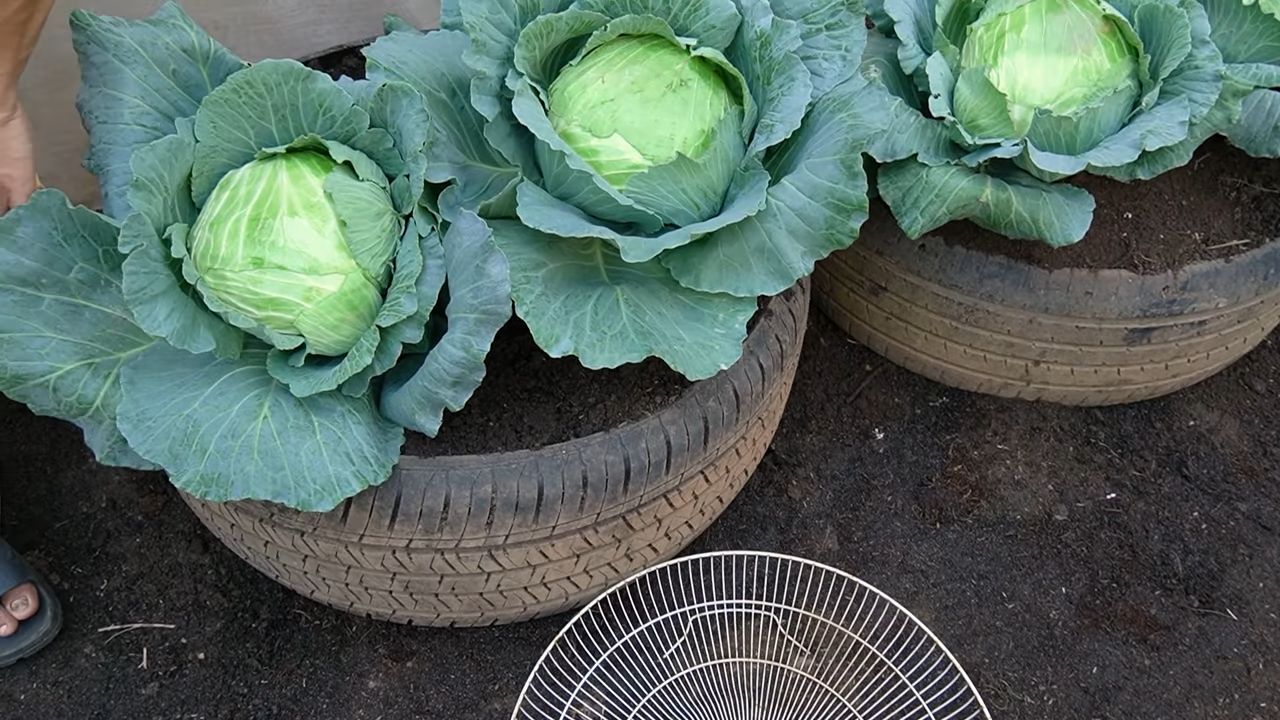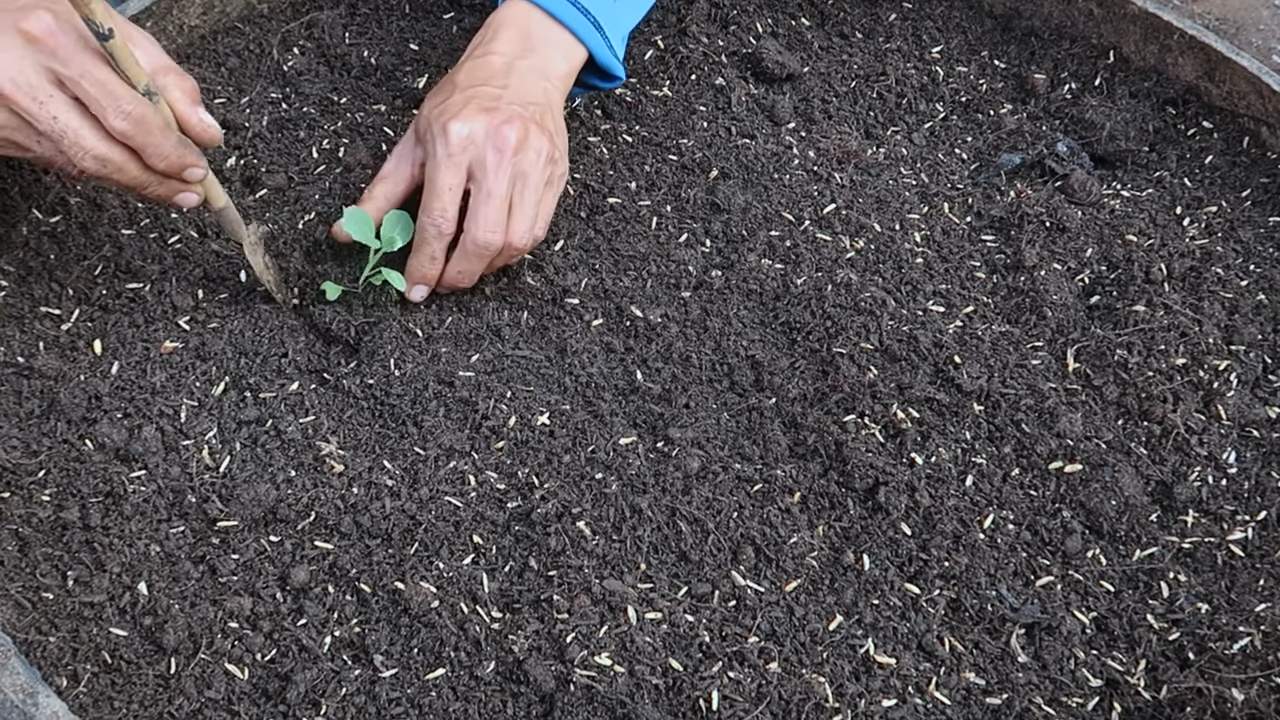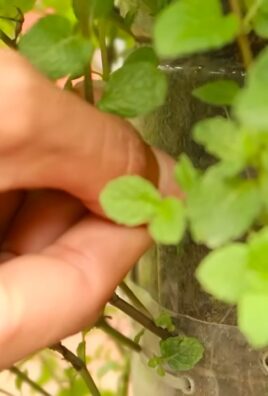Grow Cabbage at Home – and unlock a world of fresh, flavorful possibilities right in your backyard! Have you ever imagined plucking a crisp, vibrant cabbage straight from your garden to your dinner plate? It’s not just a dream; it’s an achievable reality with a few simple tricks and a dash of DIY spirit. For centuries, cabbage has been a staple in diets across the globe, from the hearty stews of Eastern Europe to the tangy slaws of America. Its cultivation dates back to ancient times, symbolizing sustenance and resilience.
But in today’s world, where grocery store produce can lack that garden-fresh zest, learning to grow cabbage at home offers a delicious and empowering solution. Imagine bypassing those wilted, overpriced heads and instead, nurturing your own thriving cabbage patch. This DIY guide will equip you with the knowledge to cultivate healthy, delicious cabbages, even if you’re a complete beginner. I’m here to show you that with the right techniques, growing your own cabbage is easier than you think, and the rewards are incredibly satisfying. Let’s get our hands dirty and embark on this exciting gardening adventure together!

Growing Cabbage at Home: A Beginner’s Guide
Hey there, fellow gardening enthusiasts! Ever thought about growing your own cabbage? It’s surprisingly rewarding, and nothing beats the taste of fresh, homegrown veggies. I’ve been growing cabbage for a few years now, and I’m excited to share my tips and tricks with you. This guide will walk you through everything you need to know, from choosing the right variety to harvesting your beautiful, leafy heads.
Choosing Your Cabbage Variety
Before we dive into the nitty-gritty, let’s talk about cabbage varieties. There are tons to choose from, each with its own unique characteristics. Here’s a quick rundown to help you decide:
* Early Cabbage: These mature quickly (around 50-60 days) and are great for early harvests. Examples include ‘Golden Acre’ and ‘Early Jersey Wakefield’.
* Mid-Season Cabbage: These take a bit longer (70-80 days) and offer a good balance between size and maturity time. ‘Copenhagen Market’ is a popular choice.
* Late Cabbage: These are your big boys, taking 80-100+ days to mature. They’re perfect for storing over winter. Think ‘Danish Ballhead’ or ‘January King’.
* Savoy Cabbage: Known for their crinkled leaves and mild flavor. ‘Savoy Ace’ is a reliable option.
* Red Cabbage: Adds a pop of color to your garden and is great for pickling. ‘Red Acre’ is a classic.
Consider your climate, growing season length, and personal preferences when making your choice. I personally love growing a mix of early and late varieties to have a continuous harvest throughout the season.
Getting Started: Seeds vs. Transplants
You have two options for starting your cabbage: seeds or transplants.
* Seeds: Starting from seed gives you more control over the entire process and is generally cheaper. However, it requires more time and effort.
* Transplants: Buying transplants from a local nursery is a convenient option, especially if you’re short on time or space. Just make sure the transplants look healthy and vigorous.
I usually start my cabbage from seed indoors about 6-8 weeks before the last expected frost. This gives them a head start and ensures I have strong, healthy plants ready to go into the garden.
Starting Cabbage from Seed (Indoors)
If you’re going the seed route, here’s what you’ll need:
* Seed starting trays or small pots
* Seed starting mix (a light, well-draining mix is essential)
* Seeds (of course!)
* A spray bottle
* A warm, bright location (or a grow light)
Now, let’s get planting!
1. Prepare your seed starting trays: Fill each cell or pot with seed starting mix, leaving about half an inch of space at the top. Gently tap the trays to settle the mix.
2. Sow the seeds: Place 2-3 seeds in each cell or pot, about ¼ inch deep. Cover with a thin layer of seed starting mix.
3. Water gently: Use a spray bottle to moisten the soil. Avoid overwatering, as this can lead to damping off (a fungal disease that kills seedlings).
4. Provide warmth and light: Place the trays in a warm location (around 70-75°F) and provide plenty of light. A sunny windowsill might work, but a grow light is ideal for consistent results.
5. Keep the soil moist: Check the soil daily and water gently when the top inch feels dry.
6. Thin the seedlings: Once the seedlings have their first true leaves (the second set of leaves), thin them to one plant per cell or pot. Snip off the weaker seedlings at the soil line with scissors.
7. Harden off the seedlings: About a week before transplanting, gradually acclimate the seedlings to outdoor conditions. Start by placing them outside for an hour or two each day, increasing the time gradually. This will help them adjust to the sun, wind, and temperature changes.
Preparing the Garden Bed
Cabbage thrives in well-drained, fertile soil with a pH of 6.0-7.0. Before transplanting, it’s crucial to prepare your garden bed properly.
1. Choose a sunny location: Cabbage needs at least 6 hours of sunlight per day.
2. Amend the soil: Dig in plenty of compost or well-rotted manure to improve soil fertility and drainage. I usually add a generous amount – about 2-3 inches – and work it in thoroughly.
3. Test the soil pH: Use a soil testing kit to check the pH. If it’s too acidic (below 6.0), add lime to raise it. If it’s too alkaline (above 7.0), add sulfur to lower it.
4. Remove weeds: Clear the area of any weeds, as they can compete with your cabbage for nutrients and water.
5. Create planting holes: Space the planting holes according to the mature size of the cabbage variety you’re growing. Generally, early varieties need about 12-18 inches between plants, while late varieties need 18-24 inches.
Transplanting Your Cabbage
Once your seedlings are hardened off and your garden bed is prepared, it’s time to transplant!
1. Water the seedlings: Water the seedlings thoroughly a few hours before transplanting. This will help them handle the stress of being moved.
2. Carefully remove the seedlings: Gently remove the seedlings from their cells or pots, being careful not to damage the roots.
3. Plant the seedlings: Place each seedling in a planting hole, making sure the top of the root ball is level with the soil surface.
4. Backfill with soil: Fill the planting holes with soil and gently firm around the base of the plants.
5. Water thoroughly: Water the newly transplanted cabbage thoroughly to help them settle in.
6. Mulch: Apply a layer of mulch around the plants to help retain moisture, suppress weeds, and regulate soil temperature. I like to use straw or shredded leaves.
Caring for Your Cabbage
Now that your cabbage is in the ground, it’s time to provide them with the care they need to thrive.
* Watering: Cabbage needs consistent moisture, especially during head formation. Water deeply whenever the top inch of soil feels dry. Avoid overhead watering, as this can promote fungal diseases. Drip irrigation is ideal.
* Fertilizing: Cabbage is a heavy feeder, so regular fertilization is essential. Apply a balanced fertilizer (e.g., 10-10-10) every 2-3 weeks, following the package instructions. You can also side-dress with compost or well-rotted manure.
* Weeding: Keep the garden bed free of weeds, as they can compete with your cabbage for nutrients and water. Hand-pull weeds regularly or use a hoe to cultivate the soil.
* Pest Control: Cabbage can be susceptible to various pests, including cabbage worms, aphids, and flea beetles. Regularly inspect your plants for signs of infestation.
* Cabbage Worms: These green caterpillars can quickly devour your cabbage leaves. Hand-picking them off is an effective method for small infestations. For larger infestations, use Bacillus thuringiensis (Bt), a natural insecticide that targets caterpillars.
* Aphids: These tiny insects suck the sap from plants, causing them to weaken and distort. Spray aphids with a strong stream of water or use insecticidal soap.
* Flea Beetles: These small, jumping beetles can create tiny holes in cabbage leaves. Cover your plants with row covers to prevent flea beetles from reaching them.
* Disease Prevention: Cabbage can also be affected by fungal diseases, such as black rot and clubroot.
* Black Rot: This bacterial disease causes yellowing and browning of the leaves, eventually leading to plant death. Prevent black rot by using disease-free seeds and transplants, practicing crop rotation, and avoiding overhead watering.
* Clubroot: This fungal disease causes swollen, distorted roots, stunting plant growth. Prevent clubroot by maintaining a soil pH of 7.0 or higher, practicing crop rotation, and using disease-resistant varieties.
Harvesting Your Cabbage
The moment you’ve been waiting for! Knowing when to harvest your cabbage is key to enjoying its best flavor and texture.
* Check for firmness: The cabbage head should feel firm and solid when squeezed gently.
* Consider size: The size of the head will vary depending on the variety, but it should be close to the expected mature size.
* Look for maturity: The outer leaves should be tightly wrapped around the head.
* Harvesting: Use a sharp knife to cut the cabbage head

Conclusion
So, there you have it! Growing cabbage at home is not only achievable but also incredibly rewarding. From the satisfaction of nurturing a tiny seedling to the joy of harvesting a crisp, flavorful head of cabbage, the entire process is a testament to the magic of gardening. We’ve walked you through the essential steps, from selecting the right variety to protecting your precious plants from pests and diseases.
But why should you embark on this cabbage-growing adventure? The answer is simple: freshness, flavor, and control. Store-bought cabbage, while convenient, often lacks the vibrant taste and crisp texture of homegrown varieties. Plus, when you grow your own, you know exactly what’s going into your food – no mystery pesticides or questionable farming practices. You have complete control over the growing environment, ensuring a healthy and delicious harvest.
This DIY trick of growing cabbage at home is a must-try for several reasons. First, it’s a fantastic way to connect with nature and learn about the food you eat. Second, it’s a budget-friendly alternative to buying cabbage from the store, especially if you consume it regularly. Third, it’s a sustainable practice that reduces your carbon footprint by eliminating the need for transportation and packaging.
Looking for variations? Consider experimenting with different cabbage varieties. Red cabbage adds a beautiful splash of color to your salads and slaws, while Savoy cabbage offers a milder, more delicate flavor. You can also try growing Asian cabbage varieties like Napa or Bok Choy for stir-fries and other Asian-inspired dishes. Don’t be afraid to get creative and tailor your cabbage garden to your specific tastes and preferences.
Another variation is to explore companion planting. Cabbage thrives alongside certain plants, such as dill, chamomile, and rosemary, which can help deter pests and improve growth. Conversely, avoid planting cabbage near strawberries or tomatoes, as they can compete for resources or attract unwanted pests.
Furthermore, think about succession planting. By planting new cabbage seedlings every few weeks, you can ensure a continuous harvest throughout the growing season. This is especially useful if you have a large family or enjoy eating cabbage frequently.
We wholeheartedly encourage you to give this DIY trick a try. Whether you have a sprawling backyard or a small balcony, there’s a way to grow cabbage at home. Start small, learn as you go, and don’t be discouraged by setbacks. Gardening is a journey, and every mistake is an opportunity to learn and improve.
Once you’ve harvested your first head of homegrown cabbage, we’d love to hear about your experience. Share your photos, tips, and stories with us in the comments below. Let’s create a community of cabbage-growing enthusiasts and inspire others to embrace the joys of gardening. Happy growing!
Frequently Asked Questions (FAQ)
What is the best time of year to start growing cabbage?
The best time to start growing cabbage depends on your climate. In general, cabbage is a cool-season crop that thrives in temperatures between 60°F and 70°F (15°C and 21°C). For spring crops, start seeds indoors 6-8 weeks before the last expected frost. For fall crops, start seeds indoors in mid-summer. In warmer climates, you can grow cabbage throughout the winter. Check your local frost dates to determine the optimal planting time for your region.
What kind of soil does cabbage need?
Cabbage prefers well-drained, fertile soil that is rich in organic matter. The ideal soil pH is between 6.0 and 7.0. Before planting, amend your soil with compost or well-rotted manure to improve drainage and fertility. If your soil is heavy clay, consider adding sand or perlite to improve drainage. A soil test can help you determine the specific nutrient needs of your soil.
How much sunlight does cabbage need?
Cabbage needs at least 6 hours of sunlight per day to thrive. Choose a planting location that receives full sun for most of the day. If you live in a hot climate, some afternoon shade can be beneficial to prevent the cabbage from bolting (going to seed prematurely).
How often should I water my cabbage plants?
Cabbage plants need consistent moisture to grow properly. Water deeply and regularly, especially during dry periods. Aim to keep the soil consistently moist but not waterlogged. Mulching around the plants can help retain moisture and suppress weeds. Check the soil moisture regularly by sticking your finger into the soil. If the top inch feels dry, it’s time to water.
What are some common pests and diseases that affect cabbage?
Cabbage is susceptible to several pests and diseases, including cabbage worms, cabbage loopers, aphids, flea beetles, and clubroot. To prevent pest problems, inspect your plants regularly and remove any pests you find. You can also use row covers to protect your plants from insects. To prevent diseases, choose disease-resistant varieties and practice crop rotation. If you encounter serious pest or disease problems, consult with your local agricultural extension office for advice on appropriate treatments.
How do I harvest cabbage?
Cabbage is ready to harvest when the head is firm and solid. The size of the head will vary depending on the variety. To harvest, use a sharp knife to cut the head from the stem, leaving a few outer leaves attached. You can store cabbage in the refrigerator for several weeks.
Can I grow cabbage in containers?
Yes, you can grow cabbage in containers, but you’ll need to choose a large container (at least 12 inches in diameter) and use a well-draining potting mix. Be sure to water regularly and fertilize every few weeks. Container-grown cabbage may not grow as large as cabbage grown in the ground, but it’s still a great way to enjoy fresh, homegrown cabbage, especially if you have limited space.
What are some good companion plants for cabbage?
Good companion plants for cabbage include dill, chamomile, rosemary, thyme, and marigolds. These plants can help deter pests and improve growth. Avoid planting cabbage near strawberries or tomatoes, as they can compete for resources or attract unwanted pests.
How can I prevent cabbage from splitting?
Cabbage heads can split if they receive too much water after a dry period. To prevent splitting, water regularly and consistently, especially during dry spells. You can also try cutting a small slit in the side of the head to relieve pressure.
Is it possible to grow organic cabbage?
Absolutely! Growing organic cabbage is a great way to ensure that you’re eating healthy, pesticide-free food. Use organic seeds and seedlings, amend your soil with compost and other organic matter, and use natural pest control methods. With a little extra effort, you can easily grow delicious and nutritious organic cabbage at home.




Leave a Comment